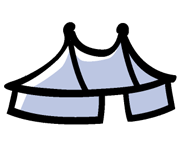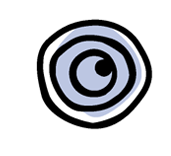Arts de la piste15 October 2004
Waterspouts, Raindrops and Waterfalls
Elsewhere, Dripping Water Takes on a Torturous Aspect. Here, Lively, Miniscule Water Droplets Burst Rythmically on the Floor or at the Bottom of Pots and Pans Selected for their Musicality, and Make Themselves the Star of the Show. As a Solitary Drop Water Annoys, in a Stream it Disturbs, in a Waterfall it Drowns.
Pascal Jacob
Cirque Plume
Plic Ploc
Waterspouts, Raindrops and Waterfalls
The setting is a rectangular stage; it is obscure and deep, just as it should be. Seated and playful, the audience squirms with the impatience sometimes characteristic of a room full of invited guests, unaware of the drama that has been unfolding right under their noses for the last few minutes: an insolent drop of water is sullying the order of the evening. A singular pas de deux, both uneasy and precise, is taking place in the half-light, a domestic ballet involving mops and various receptacles. This falling water, this inexorable source of dysfunction, is the driving force of the show. It is a comic prelude, but also a warning: be wary of dripping water, be prepared at any moment to lose your footing and be swept away by the flood.
In fact, impressive quantities of water, shooting out from everywhere, will pour, run, ooze, squirt, and contradict the metronomic precision of the show. Water that rains and trickles down soaks its world at irregular intervals, causing a remarkable effect on the spectators. When is the next shower, jet, drip or puddle? The audience quickly becomes complicit in the misfortune of the acrobats who are immersed up to their eyeballs as the inescapable bath scene of varying intensity and geometry unfolds before them. This crazy exercise in fluid dynamics puts the security normally necessary on a circus stage at risk. The space becomes unstable, worrisome, and transformed.
The water spreads out like a mirror; it slips, slides, and in this case, reflects troubled forms. Translucence is never in vain. The protagonists (water, acrobats) incessantly swim against the tide, evoking vigorous circus slapstick with an aqueous tendency. The show is a succession of tableaux organized by ever increasing levels of hygrometry and curiosity. It is difficult to forget the troubling image of dozens of metronomes adorned with red flowers, ticking in syncopation, creating a sonorous pathway and an uncommon visual tableau. There is also a white canvas that separates, conceals and controls the rhythm of the acrobatic passages. It splits the show into multiple stanzas, all linked to each other by an irresistible thirst.
To top it all off, when it stops raining on the stage we wait impatiently for the next shower. This is the perverse effect of a comic situation intimately linked to its repetition. In reality, we ask for such repetition, and we receive it in buckets. We receive nothing but pleasure and excitement: a large translucent white fabric, as a result of being manipulated and drenched, evolves into a fragile veil that we expect would be torn to shreds should a gust of wind envelop the stage…this immense surface serves an enormous screen where unforeseen images are poured out and projected. A strange vertical beach appears on this watered silk, where timid silhouettes cross paths, meet, embrace, and trace a giant heart, the symbol of their eternal love that in turn is erased by the caress of a team of diligent "water pushers" with their squeegees. Directed by Bernard Kudlak, deus ex aqua inspired, this show is, as usual, marked by the love for beautiful work that makes the drenched protagonists radiate. Plic Ploc is an homage to simplicity, a style often cliché but which in this case is a majestic accomplishment generously offered. Paradoxically, the show takes it meaning throughout the sumptuous compositions that owe everything to almost nothing.
The water juggling, for example, is one of the most dazzling demonstrations of virtuosity, bringing together magic, anecdote, tenderness, image and human prowess, two hands, two feet, and a little spurt of water. Evidently this theory of simplicity is also the pretext for putting to work a tremendous theatre of fantastic and whimsical objects, like a congregation of blood red umbrellas (surprise, surprise) that metamorphoses into a disturbing placid creature, talented and greedy, capable of swallowing his trainer and then spitting him out, stark naked. And dry.
The carnival of animated creatures at Plume, innately flexible silhouettes adorned with thwacking flippers, trombones, antlers and umbrellas, give themselves with open hearts in order to enlighten the eye of the audience, who is transported by the quality of the troupe’s inventiveness and drowned in a complicit smile. Subtly traced, these silhouettes resonate in the imagination of those that contemplate them. Their song tells us that, it’s not because it’s raining that it’s raining. Indeed. But it’s worth your while to go see for yourself.









